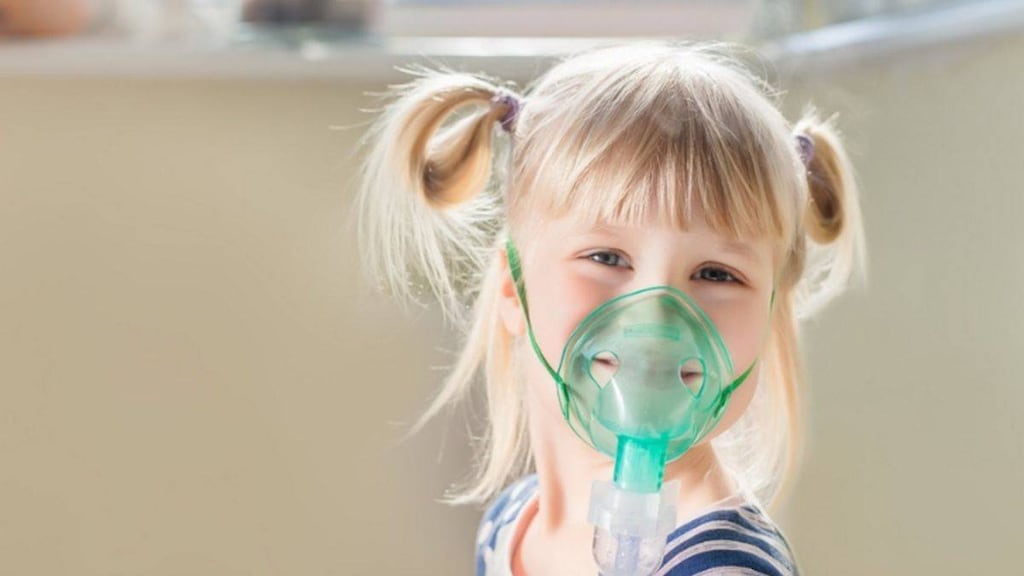Dosage Forms
Excipient information presented when available (limited, particularly for generics); consult specific product labeling.
Capsule, Inhalation:
Tobi Podhaler: 28 mg
Nebulization Solution, Inhalation:
Generic: 300 mg/5 mL (5 mL)
Nebulization Solution, Inhalation [preservative free]:
Bethkis: 300 mg/4 mL (4 mL)
Kitabis Pak: 300 mg/5 mL (5 mL)
Tobi: 300 mg/5 mL (5 mL)
Generic: 300 mg/5 mL (5 mL)
Pharmacology
Mechanism of Action
Interferes with bacterial protein synthesis by binding to 30S ribosomal subunit, resulting in a defective bacterial cell membrane
Pharmacokinetics/Pharmacodynamics
Absorption
Inhalation: Peak serum concentrations:
Solution for inhalation: ~1 mcg/mL following a 300 mg dose
Powder for inhalation: ~1 mcg/mL (range: 0.49 to 1.55 mcg/mL) following a 112 mg dose
Distribution
Powder for inhalation: Vd (central compartment) for a typical cystic fibrosis patient: 85.1 L
Time to Peak
Serum: Powder for inhalation: 60 minutes
Half-Life Elimination
Solution for inhalation: ~4.4 hours (Bethkis); ~3 hours (TOBI)
Powder for inhalation: ~3 hours (after a single 112 mg dose)
Use: Labeled Indications
Cystic fibrosis: Management of cystic fibrosis in adults and pediatric patients ≥6 years of age with Pseudomonas aeruginosa.
Limitations of use: Safety and efficacy have not been demonstrated in patients with FEV1 <40% or >80% predicted (Bethkis) or FEV1 <25% or >80% predicted (TOBI Podhaler) or FEV1 <25% or >75% predicted (Kitabis Pak; TOBI), or in patients colonized with Burkholderia cepacia.
Use: Off Label
Non-cystic fibrosis bronchiectasiscyes
According to a national consensus summary and international guidelines, aerosolized tobramycin should not be used for the treatment and prevention of non-cystic fibrosis bronchiectasis. Aerosolized antibiotics may be considered in patients who have experienced 3 or more exacerbations requiring antibiotic therapy per year; organism sensitivity should be considered when choosing an antibiotic. The risk of adverse events, cost of therapy, and patient status should be considered prior to initiating aerosolized tobramycin because the efficacy of aerosolized tobramycin in the treatment of non-cystic fibrosis bronchiectasis has not been well documented SIDP [Le 2010], BTS [Pasteur 2010].
Contraindications
Hypersensitivity to tobramycin, other aminoglycosides, or any component of the formulation
Dosage and Administration
Dosing: Adult
Cystic fibrosis: Inhalation:
Bethkis, Kitabis Pak, Tobi: 300 mg every 12 hours (do not administer doses <6 hours apart); administer in repeated cycles of 28 days on drug followed by 28 days off drug.
Tobi Podhaler: 112 mg (4 x 28 mg capsules) every 12 hours (do not administer doses <6 hours apart); administer in repeated cycles of 28 days on drug followed by 28 days off drug.
Missed dose: If <6 hours before next scheduled dose, skip the missed dose and resume usual dosing schedule.
Non-cystic fibrosis bronchiectasis (off-label use): Note: Use may be considered in patients who have ≥3 exacerbations requiring antibiotic therapy per year; generally given in addition to oral or IV antimicrobials. Inhalation for nebulization:
Acute exacerbation: 80 mg twice daily; Note: Dose prepared from preservative-free tobramycin injection solution (Le 2010).
Suppression: 160 mg or 300 mg twice daily. Note: 160 mg dose prepared from preservative-free tobramycin injection solution (Pasteur 2010).
Dosing: Pediatric
Pulmonary infection: Inhalation:
Cystic fibrosis (CF) patients: Children ≥6 years and Adolescents:
Bethkis, Kitabis Pak, TOBI: 300 mg every 12 hours; administer in repeated cycles of 28 days on drug, followed by 28 days off drug
TOBI Podhaler: 112 mg (4 x 28 mg capsules) every 12 hours; administer in repeated cycles of 28 days on drug followed by 28 days off drug
Noncystic fibrosis patients: Limited data available: Note: Doses are from initial studies of CF patients using the IV product as inhalation (MacLusky 1989; Steinkamp 1989). Some centers utilize this dose in non-CF patients for treatment of pulmonary disease (eg, bronchiectasis, tracheitis) (Rubin 2008): Children and Adolescents: 80 mg/dose 2 to 3 times daily
Administration
Inhalation:
Bethkis, Kitabis Pak, Tobi: To be orally inhaled over ~15 minutes using a handheld reusable nebulizer (PARI-LC PLUS) with a PARI Vios air compressor (Bethkis) or a DeVilbiss Pulmo-Aide air compressor (Kitabis Pak, Tobi). If multiple different nebulizer treatments are required, administer bronchodilator first, followed by chest physiotherapy, any other nebulized medications, and then tobramycin last. Do not mix with other nebulizer medications.
Tobi Podhaler: Capsules should be administered by oral inhalation via Podhaler device following manufacturer recommendations for use and handling. Capsules should be removed from the blister packaging immediately prior to use and should not be swallowed. Patients requiring bronchodilator therapy should administer the bronchodilator 15 to 90 minutes prior to Tobi Podhaler. The sequence of chest physiotherapy and additional inhaled therapies is at the discretion of the healthcare provider; however, Tobi Podhaler should always be administered last. The Canadian labeling recommends that patients requiring bronchodilator therapy should administer the bronchodilator 15 to 90 minutes prior to administering Tobi Podhaler.
Storage
Powder, for inhalation (Tobi Podhaler): Store in original package at 25°C (77°F); excursions permitted to 15°C to 30°C (59°F to 86°F). Protect from moisture.
Solution, for inhalation (Bethkis, Kitabis Pak, Tobi): Store under refrigeration at 2°C to 8°C (36°F to 46°F). May be stored in foil pouch (opened or unopened) at room temperature of 25°C (77°F) for up to 28 days. Protect from light. The colorless to pale yellow solution may darken over time if not stored under refrigeration; however, the color change does not affect product quality. Do not use if solution has been stored at room temperature for >28 days.
Drug Interactions
Loop Diuretics: May enhance the nephrotoxic effect of Tobramycin (Oral Inhalation). Loop Diuretics may enhance the ototoxic effect of Tobramycin (Oral Inhalation). Monitor therapy
Mannitol (Systemic): May enhance the nephrotoxic effect of Tobramycin (Oral Inhalation). Avoid combination
Adverse Reactions
>10%:
Central nervous system: Voice disorder (4% to 14%), headache (11% to 12%)
Respiratory: Cough (powder: 10% to 48%, solution: 31%), rhinitis (solution: 11% to 35%), pulmonary disease (30% to 34%; includes pulmonary or cystic fibrosis exacerbations), reduced forced expiratory volume (solution: 1% to 31%, powder: 4%), discoloration of sputum (21%), productive cough (18% to 20%), rales (solution: 6% to 19%, powder: 7%), dyspnea (12% to 16%), decreased lung function (7% to 16%), oropharyngeal pain (11% to 14%), hemoptysis (12% to 13%), pharyngolaryngeal pain (powder: 11%, solution: 3%)
Miscellaneous: Fever (12% to 16%)
1% to 10%:
Cardiovascular: Chest discomfort (3% to 7%)
Central nervous system: Malaise (6%)
Dermatologic: Skin rash (2%)
Endocrine: Increased serum glucose (powder: 3%, solution: <1%)
Gastrointestinal: Nausea (8% to 10%), dysgeusia (powder: 4% to 7%, solution: <1%), vomiting (6%), diarrhea (2% to 4%)
Hematologic & oncologic: Increased erythrocyte sedimentation rate (solution: 8%), eosinophilia (solution: 2%), increased serum immunoglobulins (solution: 2%)
Neuromuscular & skeletal: Musculoskeletal chest pain (<1% to 5%), myalgia (solution: ≤5%)
Otic: Hypoacusis (powder: 10%), tinnitus (2% to 3%), deafness (≤1%; including unilateral deafness, reported as mild to moderate hearing loss or increased hearing loss)
Respiratory: Upper respiratory tract infection (7% to 9%), nasal congestion (7% to 8%), wheezing (5% to 7%), throat irritation (2% to 5%), bronchospasm (≤1% to 5%), laryngitis (solution: ≤5%) bronchitis (solution: 3%), epistaxis (2% to 3%), tonsillitis (solution: 2%)
<1%, postmarketing, and/or case reports: Aphonia, decreased appetite, hypersensitivity reaction, increased bronchial secretions, pneumonitis, pruritus, pulmonary congestion, urticaria
Warnings/Precautions
Concerns related to adverse effects:
- Bronchospasm: Bronchospasm may occur; bronchospasm or wheezing should be treated appropriately if either arise.
- Nephrotoxicity: Nephrotoxicity was not observed during tobramycin inhalation clinical studies, but has been associated with aminoglycosides. Patients with known or suspected renal dysfunction or taking concomitant nephrotoxic drugs should be closely monitored (renal function tests and serum tobramycin concentrations) as clinically indicated. If nephrotoxicity occurs, discontinue therapy until serum concentrations fall below 2 mcg/mL.
- Neuromuscular disorders: Use with caution in patients with neuromuscular disorders, including myasthenia gravis and Parkinson disease; neuromuscular blockade, respiratory failure, and prolonged respiratory paralysis may occur. Concomitant neuromuscular blocking agents may also increase risk for prolonged respiratory paralysis.
- Ototoxicity: Ototoxicity, as measured by complaints of hearing loss or tinnitus, has been reported. Tinnitus may be a sentinel symptom of ototoxicity, and therefore, the onset of this symptom warrants further investigation. Ototoxicity, manifested as both auditory and vestibular toxicity, has been reported with parenteral aminoglycosides. Vestibular toxicity may be manifested by vertigo, ataxia, or dizziness. Patients with known or suspected auditory or vestibular dysfunction should be closely monitored (audiometric evaluations and serum tobramycin concentrations). Baseline audiogram should be considered for patients at increased risk of auditory dysfunction. Use with caution in patients with preexisting vertigo, tinnitus, or hearing loss.
Monitoring Parameters
The utility of monitoring serum concentrations in patients with renal impairment should be per health care provider discretion; serum concentrations achieved following inhalation are significantly less than those achieved following parenteral therapy in patients with normal renal function. Monitor serum tobramycin concentrations in patients with known or history of auditory dysfunction, renal dysfunction, and/or concomitant use of nephrotoxic drugs. One hour after inhalation, serum concentrations of 1 to 2 mcg/mL have been observed.
Pregnancy
Pregnancy Considerations
Aminoglycosides may cause fetal harm if administered to a pregnant woman. Systemic absorption of tobramycin following oral inhalation is expected to be low compared to intravenous administration; however, systemic exposure was associated with total irreversible bilateral congenital deafness in children whose mothers received another aminoglycoside during pregnancy.
Tobramycin inhalation may be used for the management of cystic fibrosis in pregnant patients with Pseudomonas aeruginosa (Edenborough 2008).
Patient Education
What is this drug used for?
- It is used in people with cystic fibrosis to treat a certain type of bacterial infection.
Frequently reported side effects of this drug
- Headache
- Increased saliva
- Mouth pain
- Throat pain
- Sore throat
- Change in taste
- Noisy breathing
- Change in voice
- Runny nose
- Nausea
- Vomiting
Other side effects of this drug: Talk with your doctor right away if you have any of these signs of:
- Kidney problems like unable to pass urine, blood in the urine, change in amount of urine passed, or weight gain.
- Change in balance
- Dizziness
- Passing out
- Muscle weakness
- Noise or ringing in the ears
- Trouble hearing
- Hearing loss
- Persistent cough
- Coughing up blood
- Trouble breathing
- Wheezing
- Signs of a significant reaction like wheezing; chest tightness; fever; itching; bad cough; blue skin color; seizures; or swelling of face, lips, tongue, or throat.
Note: This is not a comprehensive list of all side effects. Talk to your doctor if you have questions.
Consumer Information Use and Disclaimer: This information should not be used to decide whether or not to take this medicine or any other medicine. Only the healthcare provider has the knowledge and training to decide which medicines are right for a specific patient. This information does not endorse any medicine as safe, effective, or approved for treating any patient or health condition. This is only a brief summary of general information about this medicine. It does NOT include all information about the possible uses, directions, warnings, precautions, interactions, adverse effects, or risks that may apply to this medicine. This information is not specific medical advice and does not replace information you receive from the healthcare provider. You must talk with the healthcare provider for complete information about the risks and benefits of using this medicine.




